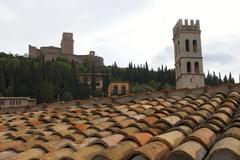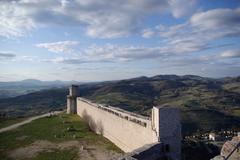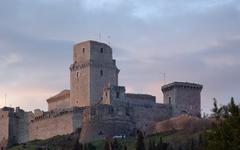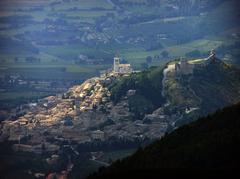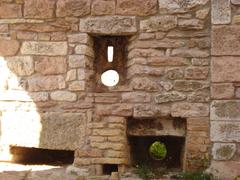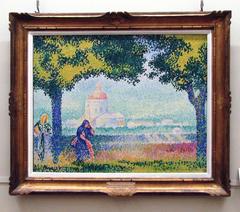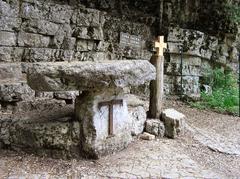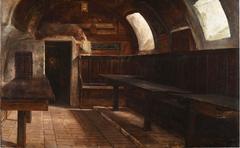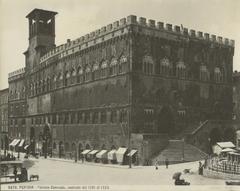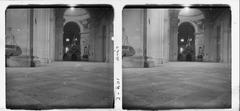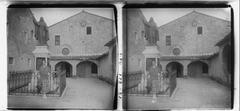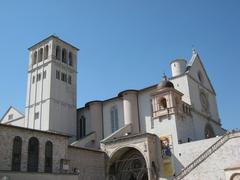
Visiting Rocca Maggiore in Assisi: Tickets, Hours, and Travel Tips
Date: 18/07/2024
Introduction
Perched atop Mount Subasio, Rocca Maggiore is a monumental fortress that has stood the test of time, overlooking the spiritual town of Assisi. This guide serves as a comprehensive resource for those planning to visit this historic landmark, offering insights into its rich history, architectural marvels, and practical visitor information.
Rocca Maggiore’s origins date back to the 12th century, a period marked by power struggles between the Holy Roman Empire and the papacy. Reconstructed and expanded over the centuries, this fortress has transformed from a military stronghold to a residence and now stands as a testament to Assisi’s complex past. Whether you’re intrigued by medieval military architecture, panoramic views of the Umbrian countryside, or the historical forces that shaped Assisi, Rocca Maggiore promises a memorable experience. For those planning a visit, this guide covers everything from visiting hours and ticket prices to travel tips and nearby attractions, ensuring a well-rounded and enriching visit.
Table of Contents
- [Introduction](#introductionintroduction)
- [Historical Background and Significance](#historical-background-and-significancehistorical-background-and-significance)
- [Early Beginnings and Papal Influence](#early-beginnings-and-papal-influenceearly-beginnings-and-papal-influence)
- [Papal Reconstruction and Expansion](#papal-reconstruction-and-expansionpapal-reconstruction-and-expansion)
- [A Fortress in Transition - From Defense to Residence](#a-fortress-in-transition---from-defense-to-residencea-fortress-in-transition---from-defense-to-residence)
- [Decline, Restoration, and Modern Significance](#decline-restoration-and-modern-significancedecline-restoration-and-modern-significance)
- [Visitor Information](#visitor-informationvisitor-information)
- [Visiting Hours](#visiting-hoursvisiting-hours)
- [Tickets](#ticketstickets)
- [Travel Tips](#travel-tipstravel-tips)
- [Nearby Attractions](#nearby-attractionsnearby-attractions)
- [Accessibility](#accessibilityaccessibility)
- [Unique Aspects](#unique-aspectsunique-aspects)
- [Special Events](#special-eventsspecial-events)
- [Guided Tours](#guided-toursguided-tours)
- [Photographic Spots](#photographic-spotsphotographic-spots)
- [Architectural Features and Layout of Rocca Maggiore](#architectural-features-and-layout-of-rocca-maggiorearchitectural-features-and-layout-of-rocca-maggiore)
- [The Outer Walls and Towers](#the-outer-walls-and-towersthe-outer-walls-and-towers)
- [The Inner Courtyard and Keep](#the-inner-courtyard-and-keepthe-inner-courtyard-and-keep)
- [The Walkways and Ramparts](#the-walkways-and-rampartsthe-walkways-and-ramparts)
- [Architectural Styles and Influences](#architectural-styles-and-influencesarchitectural-styles-and-influences)
- [A Journey Through Time](#a-journey-through-timea-journey-through-time)
- [Planning Your Visit](#planning-your-visitplanning-your-visit)
- [Best Time to Visit](#best-time-to-visitbest-time-to-visit)
- [Getting There](#getting-theregetting-there)
- [Exploring the Rocca](#exploring-the-roccaexploring-the-rocca)
- [Where to Stay](#where-to-staywhere-to-stay)
- [Where to Eat](#where-to-eatwhere-to-eat)
- [Tips for a Memorable Experience](#tips-for-a-memorable-experiencetips-for-a-memorable-experience)
- [FAQ](#faqfaq)
- [Conclusion](#conclusionconclusion)
- [References](#referencesreferences)
Historical Background and Significance
Early Beginnings and Papal Influence
While the exact origins of Rocca Maggiore remain shrouded in some mystery, historical records point to its existence as early as the 12th century. An early fortification, likely built around 1174, fell under the control of Duke Conrad of Lutzen, a German imperial vicar representing the Holy Roman Emperor Frederick I Barbarossa. This period marked a power struggle between the papacy and the Holy Roman Empire, with Assisi caught in the middle. In 1198, the people of Assisi, seeking autonomy and aligning themselves with the papacy, rebelled and destroyed this initial fortress. However, the Rocca’s strategic importance meant it wouldn’t remain in ruins for long.
Papal Reconstruction and Expansion
Pope Innocent III, a powerful figure determined to consolidate papal control over central Italy, ordered the reconstruction of Rocca Maggiore in 1363. This marked the beginning of the fortress we see today, a symbol of papal authority overlooking Assisi. Over the following centuries, the Rocca underwent several expansions and modifications. Pope Nicholas V added a significant tower, known as the ‘Keep’ or ‘Maschio,’ in the 15th century, further strengthening its defensive capabilities. These additions reflected the ongoing political and military challenges of the time.
A Fortress in Transition - From Defense to Residence
By the 16th century, with the decline of Assisi’s strategic importance and the changing nature of warfare, Rocca Maggiore’s role began to shift. It transitioned from a purely defensive structure to a residence for the papal governors who administered Assisi and the surrounding region. This period saw the addition of more comfortable living quarters within the fortress walls. However, the Rocca never lost its imposing presence, serving as a visual reminder of papal power even as its military function diminished.
Decline, Restoration, and Modern Significance
Following the unification of Italy in the 19th century, Rocca Maggiore was abandoned and fell into disrepair. However, its historical and cultural value was recognized, leading to a significant restoration project in the 20th century. Today, Rocca Maggiore stands as a well-preserved testament to Assisi’s complex past. It offers visitors breathtaking panoramic views of the Umbrian countryside, a glimpse into medieval military architecture, and a tangible connection to the historical forces that shaped Assisi and the Italian peninsula.
Visitor Information
Visiting Hours
Rocca Maggiore is open to visitors from 10:00 AM to 6:00 PM daily. It is recommended to check the official website or local tourist information for any changes in opening hours, especially during holidays and special events.
Tickets
Tickets for Rocca Maggiore can be purchased at the entrance or online through the official website. Prices are as follows:
- Adults: €6
- Students and Seniors: €4
- Children under 12: Free
Travel Tips
Rocca Maggiore is accessible by foot from Assisi’s town center. Comfortable walking shoes are recommended due to the steep paths leading to the fortress. Public transportation options include local buses and taxis.
Nearby Attractions
While in Assisi, visitors should also explore other historical sites such as the Basilica of Saint Francis of Assisi, the Temple of Minerva, and the Basilica of Santa Chiara.
Accessibility
Rocca Maggiore has limited accessibility for visitors with disabilities due to its medieval structure and steep terrain. It is advisable to contact the site in advance for specific accessibility information and assistance.
Unique Aspects
Special Events
Rocca Maggiore hosts various special events and festivals throughout the year, including medieval reenactments and cultural festivals. Check the official website for a schedule of upcoming events.
Guided Tours
Guided tours are available and provide in-depth insights into the history and architecture of Rocca Maggiore. Tours can be booked in advance through the official website or at the entrance.
Photographic Spots
The fortress offers several stunning spots for photography, particularly from the towers and battlements, which provide panoramic views of Assisi and the surrounding countryside.
Architectural Features and Layout of Rocca Maggiore
Standing sentinel atop Mount Subasio, Rocca Maggiore is a testament to centuries of architectural evolution. Its imposing structure, a blend of Romanesque and Gothic elements, reflects the fortress’s long and storied past.
The Outer Walls and Towers
The first line of defense, the outer walls, encircle the entire complex, punctuated by several towers of varying sizes and functions. These walls, primarily constructed during the 14th century, replaced earlier fortifications, offering a glimpse into medieval military strategy.
- The Polygon Tower: This unique, polygonal tower, added in the 15th century, stands as a testament to evolving military architecture. Its angled design offered improved defense against cannon fire, a relatively new threat at the time.
- The Main Entrance: A fortified gateway, complete with a drawbridge (now replaced by a fixed bridge), provides access to the inner courtyard. This entrance, dating back to the 14th century, showcases the defensive considerations integral to the fortress’s design.
The Inner Courtyard and Keep
Passing through the main entrance, visitors enter a large, open courtyard, the heart of Rocca Maggiore. This space, once bustling with soldiers and servants, now offers breathtaking panoramic views of Assisi and the surrounding Umbrian countryside.
- The Keep (Maschio): Dominating the courtyard is the massive, square-shaped keep, the oldest surviving part of the fortress. Built in the 12th century, it served as the ultimate stronghold during sieges. Its thick walls, small windows, and elevated position provided maximum protection. Today, visitors can climb to the top of the keep for unparalleled views.
- The Cistern: Essential for survival during sieges, a large cistern collected rainwater, ensuring a water supply even during prolonged conflicts. This ingenious feature highlights the practical considerations woven into the fortress’s design.
- The Governor’s Palace: Adjacent to the keep, the ruins of the Governor’s Palace hint at a time when Rocca Maggiore served as a seat of power. This 14th-century addition housed the Papal governor, showcasing the fortress’s administrative role.
The Walkways and Ramparts
A series of walkways and staircases wind their way along the fortress walls, offering visitors a chance to explore the different levels and perspectives.
- The Ramparts: Walking along the ramparts, visitors can trace the fortress’s perimeter, imagining the guards who once patrolled these walls. The views from here, encompassing the town of Assisi and the rolling hills beyond, are simply stunning.
- The Watchtowers: Several smaller watchtowers punctuate the ramparts, providing strategic vantage points for observing the surrounding territory. These towers, some round and some square, offer a glimpse into the constant vigilance required to defend the fortress.
Architectural Styles and Influences
Rocca Maggiore’s architecture reflects a fascinating blend of styles, a testament to its long history and the various periods of construction and renovation.
- Romanesque: The keep, with its thick walls, small windows, and simple, functional design, exemplifies the Romanesque style prevalent in 12th-century military architecture.
- Gothic: The later additions, such as the outer walls, towers, and Governor’s Palace, display elements of the Gothic style, including pointed arches and more elaborate window designs. This shift in style reflects the evolving architectural trends and military needs of the time.
A Journey Through Time
Exploring Rocca Maggiore is akin to taking a journey through time. Its architectural features and layout tell a story of strategic defense, evolving military technology, and the changing face of power in medieval Italy. The fortress stands as a powerful reminder of Assisi’s turbulent past and offers visitors a unique opportunity to connect with history in a tangible way.
Planning Your Visit
Best Time to Visit
Assisi experiences a Mediterranean climate with hot, dry summers and mild, wet winters. The best time to visit Rocca Maggiore is during the shoulder seasons (spring and fall) when the weather is pleasant for exploring the castle and enjoying the panoramic views.
- Spring (April-May): Enjoy blooming wildflowers and fewer crowds.
- Fall (September-October): Experience comfortable temperatures and vibrant autumn colors.
- Summer (June-August): While popular, be prepared for hot weather and more tourists.
- Winter (November-March): The castle may have limited hours or closures due to weather conditions.
Getting There
By Car:
- Assisi is accessible by car via the SS75 road.
- Parking is limited within the historic center, including near Rocca Maggiore. Consider parking in designated lots outside the city walls and utilizing public transportation or walking to reach the castle.
By Public Transportation:
- Assisi is well-connected by bus services from major Italian cities.
- From the Assisi bus station, it’s a scenic uphill walk to Rocca Maggiore.
By Foot:
- Exploring Assisi on foot is a rewarding experience, allowing you to soak in the city’s charm.
- Be prepared for uphill climbs, especially when reaching Rocca Maggiore. Wear comfortable shoes.
Exploring the Rocca
Allow Ample Time:
- Allocate at least 2-3 hours to fully explore Rocca Maggiore, allowing time to appreciate the castle’s architecture, exhibits, and breathtaking views.
Dress Comfortably:
- Wear comfortable shoes suitable for walking on uneven surfaces, as you’ll be navigating stone steps and pathways within the castle.
Stay Hydrated:
- Carry water, especially during warmer months, as the uphill climb to the castle can be tiring.
Capture the Views:
- Don’t forget your camera! Rocca Maggiore offers stunning panoramic views of Assisi, the surrounding countryside, and Mount Subasio.
Guided Tours:
- Enhance your visit by joining a guided tour. Local guides can provide historical context, architectural insights, and fascinating anecdotes about the castle and Assisi.
Accessibility:
- Access within the castle may be limited for visitors with mobility impairments due to its historic structure and uneven terrain. It’s advisable to check accessibility information in advance.
Where to Stay
Assisi offers a range of accommodation options, from charming guesthouses and convents to comfortable hotels. Consider staying within the historic center for easy access to attractions or opting for accommodations in the surrounding countryside for a more tranquil experience.
Where to Eat
Assisi boasts a delightful culinary scene, offering traditional Umbrian cuisine. Savor local specialties like strangozzi pasta, porchetta (roast pork), and torta al testo (flatbread). Explore the city’s restaurants, trattorias, and cafes to experience the flavors of Assisi.
Tips for a Memorable Experience
- Embrace the Pace: Assisi is best explored at a leisurely pace, allowing time to absorb its spiritual ambiance and historical significance.
- Attend Local Events: Check the Assisi event calendar for festivals, concerts, and religious celebrations that coincide with your visit.
- Learn Basic Italian Phrases: While English is spoken in tourist areas, learning a few basic Italian phrases can enhance your interactions with locals.
- Respect Religious Sites: When visiting religious sites like the Basilica of St. Francis, dress modestly and maintain a respectful demeanor.
- Savor the Simplicity: Assisi’s charm lies in its simplicity and spirituality. Embrace the tranquility and find moments for reflection during your visit.
FAQ
What are the visiting hours for Rocca Maggiore?
Visiting hours for Rocca Maggiore vary seasonally. It is recommended to check the official website for the most up-to-date information.
How much are the tickets for Rocca Maggiore?
Admission typically requires a ticket. Combined tickets for Rocca Maggiore and other Assisi attractions are often available. Purchasing tickets online in advance is advisable during peak season.
Is Rocca Maggiore accessible for visitors with mobility impairments?
Due to its historic structure and uneven terrain, access within Rocca Maggiore may be limited for visitors with mobility impairments. Checking accessibility information ahead of time is recommended.
What is the best way to get to Rocca Maggiore?
Assisi is accessible by car, public transportation, and on foot. Parking is limited within the historic center, so consider parking in designated lots outside the city walls and using public transportation or walking to reach the castle.
Conclusion
Rocca Maggiore stands as a majestic and enduring symbol of Assisi’s historical and cultural significance. From its early beginnings as a fortification under the control of the Holy Roman Empire to its reconstruction by Pope Innocent III and subsequent expansions, the fortress encapsulates centuries of political and military history. Today, the restored Rocca Maggiore offers visitors a unique opportunity to explore medieval military architecture, enjoy breathtaking views, and connect with the historical forces that have shaped Assisi. Whether you’re a history enthusiast, an architecture aficionado, or simply seeking a scenic and educational experience, Rocca Maggiore is a must-visit destination. By planning your visit carefully and following the tips provided in this guide, you can make the most of your trip to this remarkable fortress. Don’t forget to explore nearby attractions, savor the local cuisine, and take in the serene ambiance of Assisi. For more information and updates, visit the official Rocca Maggiore website.
References
- Exploring Rocca Maggiore in Assisi - History, Visiting Hours, Tickets, and More, 2024, Author source
- Exploring Rocca Maggiore - History, Architectural Marvels, and Visitor Information, 2024, Author source
- Complete Guide to Visiting Rocca Maggiore in Assisi - Hours, Tickets, and Travel Tips, 2024, Author source
